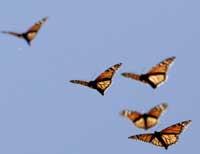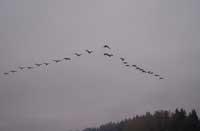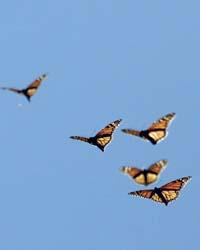Antennas, orientation and migration
2009/11/29 Lakar Iraizoz, Oihane - Elhuyar Zientzia

These butterflies have an adaptation mechanism to this mobile compass that allows them not to move along with the Sun. Well, the journal Science has announced that monarch butterflies have this mechanism on the antennas. A group of neurobiologists from the University of Massachusetts has released it through experiments with monarch butterflies.
In order to discover where this mechanism is, first the antennas were cut to butterflies and their behavior was studied. They saw that they lost all the orientation and took the randomly chosen directions to fly.
Later, instead of cutting them, they painted the antennas with enamels: a group of butterflies with opaque black enamels and another with clear enamels. It was observed that in both groups all butterflies took the same direction, so the orientation mechanism was underway. The butterflies that had the antennas painted black did not take the correct direction, since the sunlight did not reach the mechanism. The butterflies that had antennas painted with clear enamels took the right direction from the beginning.

All migrating animals need a system and reference point to help them orient themselves on the way (Photo: Eric Rider).
And those who are not butterflies, what?
Of course, in addition to butterflies, there are many animals that migrate throughout their life cycle: another large number of insects, diverse birds, bats, zebras, ñus and whales, fish like salmon, etc.
Of course, everyone needs a system and a point of reference that helps them to orient themselves in the way. The sun feeds on animals. Those who do not have antennas, and some with antennas, have the solar adaptation mechanism in their brain.
The Sun is not the only way to orient itself. For example, nocturnal animals cannot be based on the Sun. For in some of them they have seen that they take as reference the position of the moon and the stars in the sky.
To find out these kinds of things, scientists follow the method invented by a researcher named Kramer, who puts birds in a kind of cage simulating the conditions they supposedly take as a reference.
For example, the Chinese, who migrate from Europe to Asia, took a certain direction if they placed the sky seen at night in Germany or Romania, and another if they placed the sky of Cyprus.

They remember rivers, mountains, coasts, etc. they have seen in previous migrations to know where some animals should go (Photo: Tatiana Gerus).
Instead of in the sky, other animals look for references on the ground. That is, they remember the rivers, the mountains, the coasts, etc. they have seen in previous migrations to know where they should go.
And other animals are not based on vision to orient themselves. There are animals that use the Earth's magnetic field, for example. For example, some birds have found iron molecules in the brain. These molecules align with the Earth's magnetic field, just like compasses. Thus, birds know where they are and can decide where they should go.
Once all of them are read, it may seem that scientists know exactly the details of animal migration. But the truth is that they still have many things to clarify. Among others, what specific mechanisms they have in the brain and, in the case of butterflies, in antennas. It's not a little, no...
Published in 7K.

Gai honi buruzko eduki gehiago
Elhuyarrek garatutako teknologia






